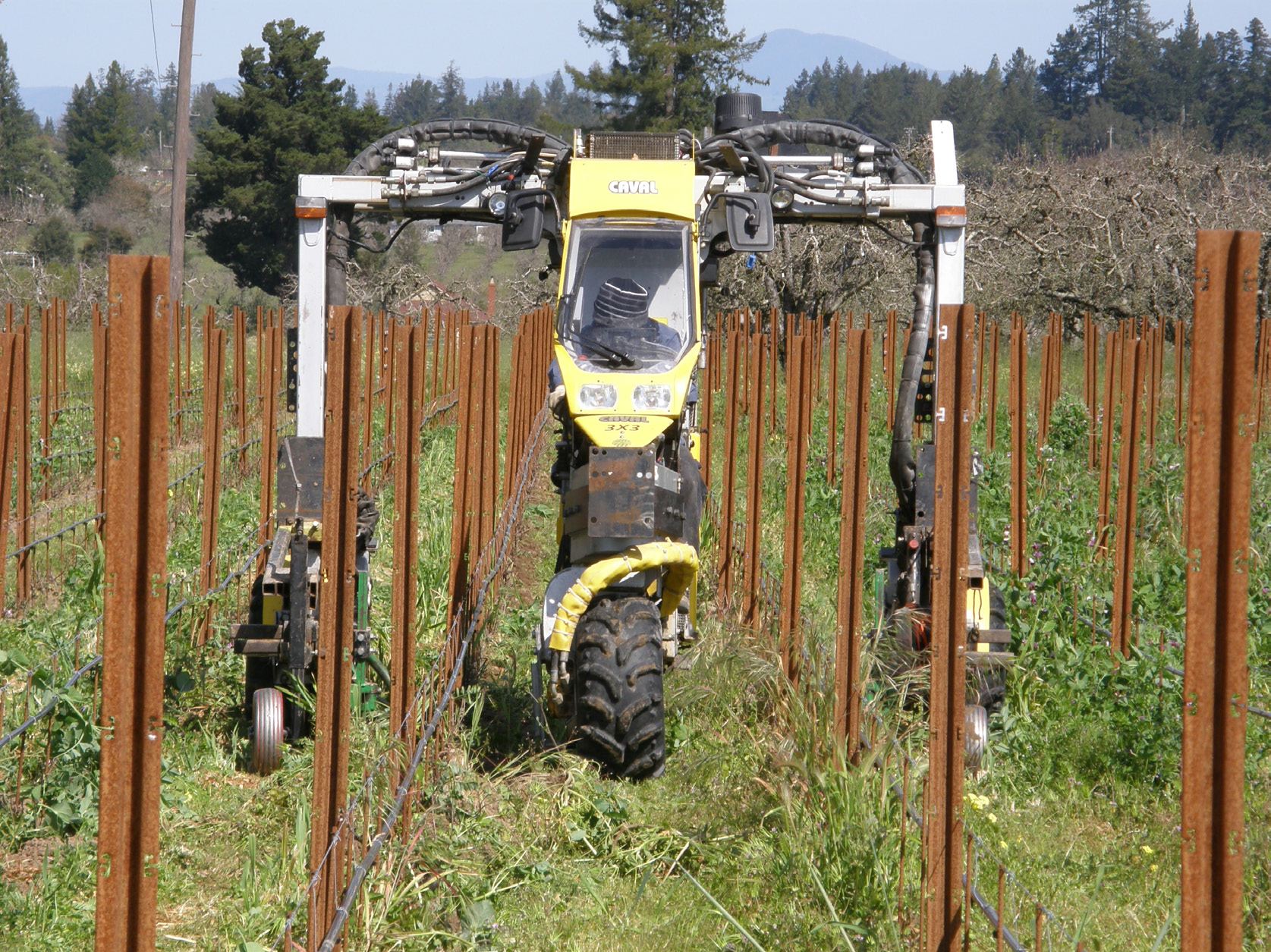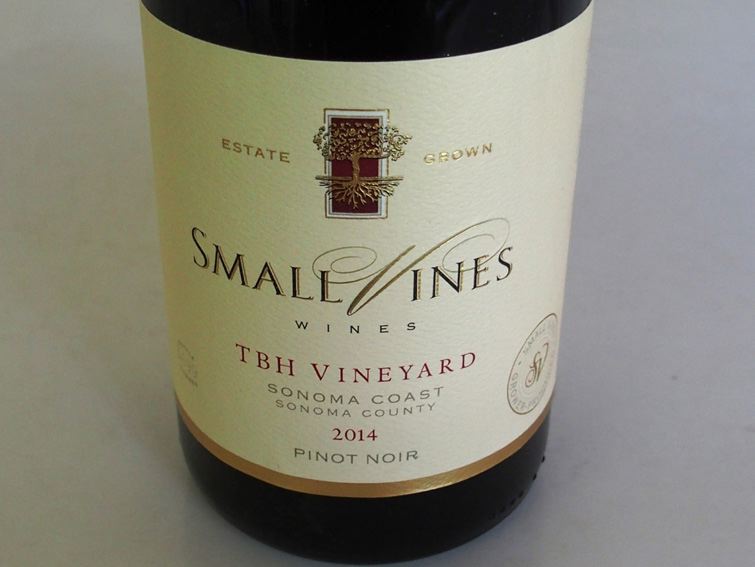Small Vines Wines Excels with High-Density Plantings
Paul and Kathryn Sloan founded a winegrowing company in the Russian River Valley called Small Vines
Viticulture in 1998. The firm’s trademarked tagline became, “The smaller the vine, the better the wine,” based
on the Sloans’ belief that high density planted vineyards similar to those in Burgundy can play an important role
in determining grape quality.
The traditional 8 feet by 12 feet (454 vines per acre) planting in California was the rule until the 1980s, after
which closer rows of 6 feet wide by vines 4 feet apart (1,816 vines per acre) became common. The vine density
in California was traditionally chosen to accommodate the tractors and implements available at the time. Wider
vine spacing was less risky and allowed tailoring of the vine budding to soil vigor. Crop thinning was then
necessary to reduce yields and concentrate flavors. As more compact farm equipment became available and
hand farming was in vogue, row and vine spacing became narrower.
Tight inter row and between row vine spacing appears to have clear advantages with Pinot Noir. Typically with
high density planting, rows are 4 feet wide and vines are 2.5 feet to 4 feet apart (2722-3630 vines per acre).
The resultant smaller vines yield less fruit without crop thinning than a standard vine, and the spacing leads to
better shading. At the same time, the amount of vines per acre is significantly increased insuring that the
vineyard has economic viability. In addition, it does not appear that high density planted vines compete with
each other in many soils with studies indicating that root density continues to increase in step with vine density.
Tight vine spacing does come at a cost, because it requires more vines to be planted, more labor, more
attention, more irrigation lines, and specialized tractor and other farm equipment. Here is a photo of the Small
Vines’ imported Caval tractor used for high density plantings.
Small Vines Viticulture specializes in the planning, instillation and precision viticulture of close spaced
vineyards in Sonoma County’s Russian River Valley and Sonoma Coast appellations. A second business
model was launched with the 2005 vintage when the Sloans offered Pinot Noir under the Small Vines Wines
label. They now produce both Russian River Valley and Sonoma Coast Pinot Noir and Chardonnay from either
estate owned or estate leased and farmed vineyards exclusively (all organically farmed). Paul handles the
winemaking in consultation with veteran winemaker Byron Kosuge.
With the release of the 2014 vintage of Small Vines Wines, the Sloans are on a roll. Paul recently recorded a
show on Grape Radio and the winery was a featured participant at the 2016 International Pinot Noir
Celebration. In 2016, they are breaking ground on their own winemaking facility on a historic property they
bought in Sebastopol.
The single-vineyard Pinot Noir and Chardonnay wines reviewed here are new releases that were recently
offered to a mailing list. For more information or to access the wines, visit www.smallvines.com. To arrange a
tasting, contact Kathryn Sloan at Kathryn@smallvines.com. There is some availability of the wines at high-end
retail stores and restaurants throughout the United States.
2014 Small Vines Sonoma Coast Pinot Noir
13.7% alc., pH 3.65, TA 0.56, RS 0.7 g/L, 675 cases, $55.
Released February 2016. TBH, Fassler, Baranoff, and MIK vineyards. Calera, Pommard, Swan, 943, “828,”
459, 114, 115, 667 and 777 planted in red sandy clay loam and Goldridge sandy loam soils, 2722-3630 vines
per acre. Harvest Brix 21.8º-23.0º. Yields 1.5-2.2 lobs per vine. 35% whole cluster. 3 to 5-day cold soak, native
primary and malolactic fermentations, aged 12 months on fine lees in French oak barrels, 30% new. Bottled
unfined and unfiltered.
·
Moderate reddish purple color in the glass. Engaging scents of black cherry, exotic
spice, rose petal and sweet smoke. Discreetly concentrated flavors of well-spiced black cherry and black
raspberry fruits framed by modest tannins and a pleasingly heady finish. Highly approachable at this young
age.
Score: 91
2014 Small Vines Estate Cuvée Russian River Valley Pinot Noir
13.5% alc., pH 3.72, TA 0.55, RS 0.5 g/L,
360 cases, $65. A proprietor’s blend of favorite barrels from Baranoff, Fassler, Old Mill, MK and TBH vineyards.
Organically farmed by Small Vines Viticulture. 2722-3630 vines per acre planted in red sandy clay loam and
Goldridge sandy loam. Yields 1.0-2.0 lbs per vine. Dijon 113, 114, 115, 667, 777 and 943. Harvest Brix
22.9º-24.8º. 50% whole cluster. 3 to 5-day cold soak, on skins 14-21 days, native primary fermentation and
malolactic fermentation. 100% free run aged 15 months on fine lees in French oak barrels, 37.5% new. Bottled
unfined and unfiltered.
·
Moderately light reddish purple color in the glass. Clean aromas of forest air, black
cherry and hay bale. On the palate, the wine aims to please with forward leaning flavors of black cherry, plum
and pomegranate accented with sweet oak. The whole cluster inclusion compliments the experience. The
tannins are balanced and the easy-going, sleek finish satisfies. This is an entirely different experience than the
Sonoma Coast bottling because of clonal differences.
Score: 91

2014 Small Vines MK Vineyard Sonoma Coast Pinot Noir
13.5% alc., pH 3.69, TA 0.54, RS 0.4 g/
L, 171 cases, $82. Released August 2016. Vineyard planted by Small Vines Viticulture in 1999 on an
east facing ridge above Occidental. Organically farmed using biodynamic practices. 4 feet x 4 feet vine
spacing (2722 vines per acre). Yields 2.5 lbs per vine. Dijon 114, 115, 667 and 777. Harvest Brix
22.7º-23.1º Brix. 50% whole cluster. 5-day cold soak, native primary and malolactic fermentations, pre
and post fermentation maceration, aged 15 months on fine lees in French oak barrels, 43% new.
Bottled unfined and unfiltered.
·
Moderate reddish purple color in the glass. A wine of immense charm
with aromas of black cherry, spice, loam, and savory herbs and an explosion of plum, black raspberry, iron and
spice flavors on the prodigious attack. Exemplary harmony with matched tannins and a glorious finish. Still
impressive the following day when tasted from a previously opened and re-corked bottle. This wine has
something extra special.
Score: 94

2014 Small Vines TBH Vineyard Sonoma Coast Pinot Noir
13.2% alc., pH 3.52, TA 0.57, RS 0.4 g/L, 309 cases, $82.
Released August 2016. Vineyard planted in 2009 on a cool and
windy ridge top in Sebastopol. Organically farmed, Goldridge
sandy loam soils. 4 feet x 3 feet vine spacing (3630 vines per
acre). Yields 1.5 lbs per vine. Calera, Pommard, Swan and 943.
Harvest Brix 22.3º-24.4º. 3 to 5-day cold soak, native primary
and malolactic fermentations, on skins 14-18 days, pre and post
fermentation maceration, aged 15 months on fine lees in French oak
barrels, 23% new. Bottled unfined and unfiltered.
·
Moderate reddish
purple color in the glass. The nose offers a lovely blend of black cherry
fruit and a savory note of herbs. The black cherry and blueberrypomegranate
flavors really wake up the mouth. Moderately bold, with
firm tannins, complimentary oak, with spice and dried herbs in the background. A marvelous wine that perfectly
balances fruit and savoriness. Even more dazzling the following day when tasted from a previously opened and
re-corked bottle.
Score: 96
2014 Small Vines Baranoff Vineyard Russian River Valley Pinot Noir
13.5% alc., pH 3.74, TA 0.56, RS 0.3
g/L, 360 cases, $82. Released August 2016. Vineyard is located above Laguna de Santa Rosa in Sebastopol
and was planted in 2001.l 4 feet x 4 feet and 4 feet by 1 meter vine spacing. Yields 1.8 lbs per vine. Calera,
777, Swan and 459. Harvest Brix 22.1º-23.5º. 75% whole cluster. 5-day cold soak, native primary and
malolactic fermentations. 100% free run. Aged 15 months on fine lees in French oak barrels, 43% new. Bottled
unfined and unfiltered.
·
Moderate reddish purple hue in the glass. Shy aromas of dark red berries, spice and
potpourri with a subtle green note. Mid weight flavors of dark red, blue and black berries are accented with a bit
of tobacco and herbal tastes. Somewhat rugged and attacking tannins persist through the finish and
superimpose their will on the fruit. The high percentage of whole cluster inclusion makes its presence felt in this
wine, but further aging in bottle should ameliorate some of that character. Unchanged when tasted the
following day from a previously opened and re-corked bottle.
Score: 90-91
2014 Small Vines Sonoma Coast Chardonnay
13.9% alc., pH 3.17, TA 0.72, RS 1.8 g/L, 574 cases, $55.
100% TBH Vineyard located in Sebastopol. Planted in 2009, organically farmed, 3630 vines per acre. Yields
1.5 lbs per vine. Hyde Wente and Kistler Mt Eden Wente selections.harvest Brix 21.8º-23.6º. Whole cluster
pressed gently, barrel fermented with native primary and malolactic fermentations, minimal lees stirring. Aged
10 months in French oak barrels (12% new) and stainless steel (16%). Bottled unfined and unfiltered.
·
Moderate golden straw color in the glass. The nose leads with aromas of freshly peeled apple, white peach,
toasty brioche and a hint of butter. Nicely composed with integrated acidity, a slightly creamy texture, flavors of
apple, nectarine, white peach and a hint of butterscotch, finishing with a node to citrus on a refreshing finish.
Score: 90
2014 Small Vines TBH Vineyard Sonoma Coast Chardonnay
13.7% alc., pH 3.13, TA 0.77, RS 1.4 g/L, 347
cases, $72. Released August 2016. Sourced from The Barlow Homestead (TBH) vineyard located on a cool
and windy ridge top in Sebastopol. Hyde Wente and Kistler Mt Eden Wente selections planted in Goldridge
sandy loam in 2009, 4’ x 3’ (3630 vines per acre). Harvest Brix 21.8º-23.6º. Whole cluster pressed slowly and
gently, barrel fermented with native yeast and native malolactic fermentation, aged 10 months on fine lees with
minimal stirring. 100% French oak barrels, 7% new. Bottled unfined and unfiltered.
·
Moderately light golden
straw color in the glass. Aromas of apple, mango, vanilla creme and butter lead to a delicious core of fresh
peach, apple, honey and lemony citrus flavors. Noticeably more vibrancy and “minerality” than the Sonoma
Coast bottling with more attack and finishing length.
Score: 92
|





